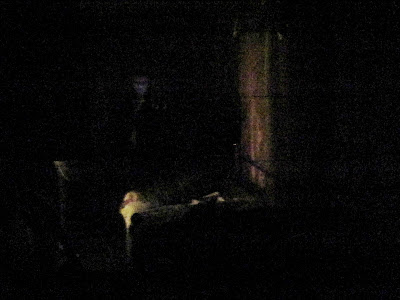It's December and a dread anniversary is approaching fast. The Christmas season is always hard. A vague sense of horror drifts down from the plains, with leaden skies and a landscape that seems impossibly bleak.It happened when I was ten; I really can't say more, otherwise I will freeze and not write another word.
It interests me, though, in an uncomfortable sort of way, to remember that I had two main books I was reading at the time. One was Tales of Terror, by Ida Chittum, and the other was Angela Carter's translation of The Fairy Tales of Charles Perrault. One was given to me by my sister. The other was a gift from my brother.Tales of Terror is still in my possession, but the fairy tale book was lost long ago. Perhaps I disposed of it in secret, as I found it unbearably creepy.
Indeed, I hadn't made the link with that translated book of fairy tales before I read Carter's classic The Bloody Chamber years later, but after reading only a few lines I was immediately hit with that sense of childhood dread. They had to have been written by the same person. An image search bore fruit - the illustrations by Martin Ware were burned into my brain.
I asked my mate, who'd never seen the book, to take a look at these illustrations and tell me what he thought.
"Good God" he said. "Is that from an Aleister Crowley manuscript? It's terrifying."
It was good to know I hadn't been imagining things back then. All that winter, I'd been troubled by the spectre of Bluebeard's wife: the forbidden key bleeding endlessly in her pocket, forever marked by her shame.
The Tales of Terror book was much more comforting for being overtly scary, and the illustrations by Franz Altschuler were meant to be frightening, unlike Ware's stark, hard-to-put-your-finger-on unease. Actually, I had spent months gazing at it hopefully in Waldenbooks, itching to make it mine. It came as a present for Halloween, and by December of that year I had read it many times.
The front cover is striking enough. The green ghosts rather reminded me of my old relatives, so it just seemed familiar and friendly, as strange as that may sound.
It was the back cover I really found unsettling.The plainness of the landscape. The sense of isolation. The shadows, which might indicate the time is just past noon.
A lonely farmhouse on the hill. We all knew what happened in places like that. Or if not, we soon would. The landscape was familiar, even though I didn't live in the Ozarks. The Texas hill country looks much the same, especially as you wind upward where the towns get further and further apart.
As it happened, we did make such a journey that December, in that gray empty space between traumas. We drove though Gruene on the way, which was still mostly a ghost town then - all abandoned buildings, fallow fields and the sound of rusted windmill blades turning. The water tower which looms on the horizon is notable for being the site of a suicide; the town manager, they say, tied a rope around his neck and flung himself off this mortal coil. All this is to say that the place disturbed me in a way that's hard to describe. You wouldn't recognize the town, the way it is now. Or maybe only a little. The old feeling is still there, in between the touristy shops. You just have to know what you're looking for. It shouldn't matter, except it does. I don't know why I recall traveling through that particular village that December. We kept driving and driving, beyond Austin and to God knows where, and I lay down in the back of the station wagon to shut out the sight of the hills and fields that seemed to go on forever.
Perhaps music could have been a distraction, but pop music was in a bad way then. Everything was ballads and minor keys and depressing. Or at least it seemed that way. The arpeggio and sighing chorus of Strawberry Letter chilled me to the bones. I couldn't shake it. Everything was wrong, but there was nothing I could do about it. I just lay there in the cold grayness, wondering if the feelings would ever stop. I couldn't foresee an end. That's one of the things trauma does to you - it takes away your future.
There is an illustration from Tales of Terror that brings these feelings back for me, from The Woman Who Turned To Paper.
It was the one story in the book that was patently silly, but the illustration haunts me the way December haunts me. Somehow, it feels so much the same. And it's kind of funny, looking at what I've written above, one wouldn't think this would have had much influence on my artistic style. A person like me prefers to avoid old horrors, not indulge them. Yet going through pictures for this post I found this little throwaway sketch:
I was somewhere between amused and disturbed to find it's nearly a combination of the Ware and Altschuler trees, above. It's amazing, what gets buried in the back of your mind.
There is one more book to mention here, or rather a story, though I hadn't read it yet. My copy of The Dynamite Book of Ghosts and Haunted Houses had not arrived from the Scholastic book club before school let out for the holidays. This was a disappointment, but it turned out my cousin had a copy at home, down south where she lived. She told me about it as we played around the area of the church where the hearses drive in, under the what do you call it, the porte-cochere. The first story in the book was called The Girl Who Was Witched Away, about a young girl who was proud of her red boots, but after the witch got her, all that was left were her bloody footprints in the snow.
Above us, the sky was full of ice.
I don't have an illustration for this story, only one I made myself, years later.
 |
| from a photo. aged 10 |
The Girl Who Was Witched Away had been my primary reason for ordering the book, but by the time school resumed in January, I was rather a different person. Trails of blood in the snow and girls who went missing had lost all appeal. It's only in recent years I began to understand my childhood horror of tales like Red Riding Hood and Donkey Skin, the knowledge that lay beneath the surface without ever being spoken. No one in our family talked about the dangers of being female, but we knew it just the same.Carter's cautionary moral at the end of Bluebeard makes it clear that the young wife's travails were her own fault, after all.
It had nothing to do with justice or fairness, this knowledge; only the reality of death on the edge of winter.












.jpg)
.jpg)
.jpg)
.jpg)
.jpg)
.jpg)















